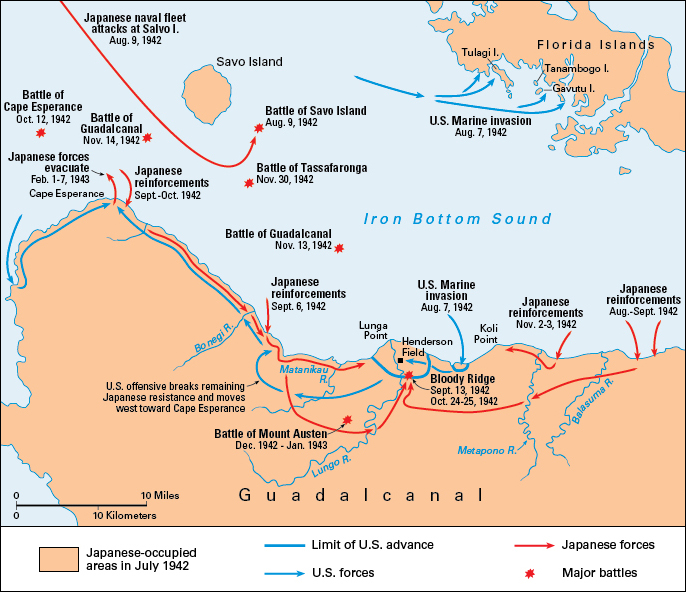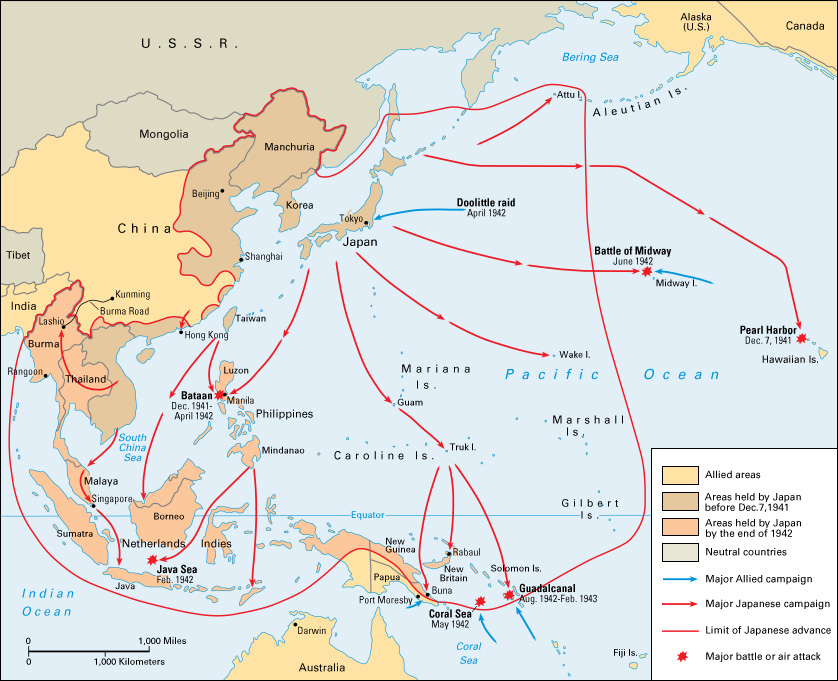Guadalcanal, Battle of, was fought between Japanese and United States forces during World War II (1939-1945). The bloody battle lasted from August 1942 to February 1943 and ended in a U.S. victory. Guadalcanal Island lies in the Coral Sea, a part of the Pacific Ocean, northeast of Australia. The American victory at Guadalcanal ended the threat of a Japanese invasion of Australia. The battle marked the first of many U.S. offensives against Japanese-held islands in the Pacific. It was the start of the United States’ long “island-hopping” campaign toward Japan.
Background.
In June 1942, U.S. forces defeated the Japanese at the Battle of Midway. The victory checked Japan’s advance in the Pacific and allowed U.S. forces to take the offensive. Earlier in 1942, the Japanese had occupied Guadalcanal Island and begun building an airfield there. Allied leaders considered the airfield a threat and planned an invasion. The plan was called Operation Watchtower.
The battle.
On August 7, U.S. Marines swarmed onto Guadalcanal’s north beaches, catching the Japanese by surprise. At first, the Marines met no resistance and established a strong beachhead (foothold). However, U.S. forces fought brief, fierce battles on the nearby islands of Gavutu, Tanambogo, and Tulagi.
The Marines took control of Guadalcanal’s unfinished airfield on August 8, still with little resistance. That night, however, Japanese warships attacked and destroyed several nearby American ships. The remaining U.S. ships withdrew the next day, leaving the Marines on Guadalcanal without supplies, reinforcements, or protection. Japanese warplanes and warships attacked American positions as Japanese reinforcements flooded onto the island.
Despite Japanese attacks, the Marines made the airfield operational. The Americans called it Henderson Field, after Major Lofton Henderson, a Marine pilot killed at Midway. American warplanes first landed on the new field on August 20. The warplanes of Henderson Field provided crucial support to the ground troops and nearby sailors throughout the campaign.
On August 21, Japan made the first of many attempts to take Henderson Field. The attack was driven back, with many Japanese casualties (soldiers killed, wounded, or missing). A larger attack followed on September 12, but it too failed. In October, U.S. Army troops reinforced the Marines. Together, they beat back assaults by about 20,000 Japanese troops.
In November, U.S. warplanes devastated an approaching Japanese convoy, preventing another large attack on the airfield. In the campaign’s final months, U.S. forces eliminated Japanese strongholds on Guadalcanal. Japanese resistance ended in February.


Aftermath.
The Japanese lost some 15,000 troops in the fighting at Guadalcanal. The U.S. Army and Marine Corps suffered about 1,500 deaths. Malaria and other diseases affected thousands from both sides. In naval action around the island, about 5,000 U.S. and Allied personnel were killed. Around 4,800 Japanese also were lost. The waters north of Guadalcanal became known as “Iron Bottom Sound” for the many ships sunk in the area.
